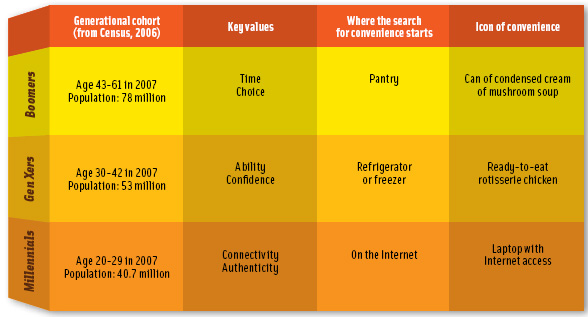How Generations View Convenience
Boomers, Gen Xers, and Millennials define convenience differently and take different approaches to meal preparation.
Convenience, as a consumer value and product benefit, has been on the table for as long as people have been rushing to put dinner there. Food marketers and companies have focused on convenience as an increasing consumer need, and food technologists have been key in this effort.

Advances in food technology have allowed companies to invent new forms of ingredients and food products with added functionality. Those advances made it possible to store foods on the shelf longer, ship foods further from their source, cook foods faster, and improve safety, flavor, texture, color, and nutritional value. Consumers no longer had to shop as frequently, or even consider seasonal availability.
Along the way, the definition and perception of convenience evolved. As consumers’ everyday lives got busier, foods formulated with specific convenience benefits provided a new kind of value for meal-preparation needs. Time savings as a type of currency entered the equation and could be quantified in “valueadded” terms—quick, instant, minute, and ready became product and brand descriptors to help connect consumers with the need to define convenience in terms of time.
 What does “convenience” mean to consumers today? It isn’t strictly about time currency anymore. Saving consumers time in the kitchen is now the required cost of entry for brands. In fact, convenience has many faces. Examined through the lens of consumer behavior, it is possible to differentiate what convenience means to each of three generations: Boomers, Gen Xers, and Millennials. Each generation may have differing convenience needs, and a one-size-fits-all strategy of time savings may not connect.
What does “convenience” mean to consumers today? It isn’t strictly about time currency anymore. Saving consumers time in the kitchen is now the required cost of entry for brands. In fact, convenience has many faces. Examined through the lens of consumer behavior, it is possible to differentiate what convenience means to each of three generations: Boomers, Gen Xers, and Millennials. Each generation may have differing convenience needs, and a one-size-fits-all strategy of time savings may not connect.
While there are differences in how the generations define convenience, one thing is constant for all: the emotional importance that cooking for family and friends represents. Cooking for others is equated with giving love and putting a sense of self into the food. Helping consumers of all generations put delicious and satisfying food on the table for their loved ones in a convenient way is an opportunity to be leveraged across generations, though the means may be different.
Boomers: Kitchen Competent
Baby Boomers (born 1946–64) generally have skills in the kitchen. Cooking and putting a meal on the table is not a problem. This group was raised during the heyday of brand marketing. Boomers connected to advertising that focused on the value of time, and they remember those convenience brands through clever jingles, slogans, and television ads. They ate the first versions of Minute Rice, Jiffy Pop popcorn, Stove Top Stuffing, Hamburger Helper, Potato Buds instant mashed potatoes, and Bisquick pancakes and biscuits. Time and choice are the key values that define convenience for Boomers.
The iconic convenience product for the Boomer generation would have to be a can of Campbell’s Condensed Cream of Mushroom Soup. Boomers recognize the red-and-white can as the glue that holds many a casserole together. It isn’t consumed as soup—rather, its use is as a convenient replacement for a classic béchamel or white sauce for one-pot dishes like beef stroganoff or tuna noodle casserole. When faced with the challenge of getting dinner on the table quickly, a Boomer’s cooking instinct goes to the pantry, reaching for that can of casserole helper.
--- PAGE BREAK ---
Given this orientation to convenience, how would Boomers cook a lasagna dinner? Typically, they would start with a jar of prepared spaghetti sauce, a pound of ground beef, a tub of cottage cheese, and a box of dried lasagna noodles. Show that collection of ingredients to a group of Boomers, and they will recognize and acknowledge that a pan of lasagna should come out of that mix, and they will likely be fairly comfortable in pulling off the dish. While the lasagna is in the oven, they will make a salad from a head of lettuce, a tomato, and a pouch of dry Italian salad dressing mix, then pop some garlic bread in the oven, made from a loaf of French bread slathered with a tub of margarine and garlic salt. Boomer cooks can still add the value to commodities like meat, grains, fruits, and vegetables by using their skill with pots and pans.
Generation X: Lost in the Space
Generation X (born 1965–77) is often described as the generation that “scratch” cooking skipped. They were raised when education and careers were emphasized more and domestic skills (cooking, sewing, home canning) were emphasized less or not at all. It is not coincidental that the microwave oven came into vogue during this generation’s formative cooking years, giving Gen Xers another reason not to cook on a stove.
Without cooking skill and a recipe repertoire easily at hand, putting dinner on the table for family and friends is an elevated stress factor for this group. Weekday dinner is less like a kitchen task and more like catering 250 or so mini-events a year. To pull this off, many Gen Xers will turn to the pros, looking to restaurants as a second dining room or as a caterer that can supply a list of take-home family favorites. While Gen Xers lack cooking ability and kitchen confidence to pull off home cooking, products that are convenient will have these key values represented and recognized by them.
The iconic product that represents Gen Xers’ concept of convenience would have to be a grocery store rotisserie chicken—ready to warm—served with a bagged salad and bottled salad dressing. In the eyes of the skill-starved, this meal is considered home-cooked. Without experience cooking from scratch, a Gen Xer might not recognize the convenience factor in a food product unless the food actually looks like a finished dish.
At home, the search for a convenient meal will likely start in the freezer or refrigerator. This is a reasonable starting point, since food companies and brands have responded to decreasing consumer cooking skills by adding more “value” to foods by preparing and pre-cooking them.
For Gen Xers, a convenient food has to look like the finished dish, so lasagna has to look like lasagna à la Costco’s or Stouffer’s frozen lasagna. Since they are already shopping in the frozen section of the grocery store, they will pick up a loaf of garlic-flavored bread. Opening a bag of prepped Caesar salad (complete with croutons, grated Parmesan, and dressing) completes the meal. While the lasagna is in the oven, they help the kids with homework, pay a few bills online, and look at new kitchen designs for their scheduled remodel. Gen Xers may not know much about cooking, but their aspirational kitchens often look like they could.
Millennials: The Cooking Curious
Millennials (born 1978–2007)—young and old—are showing an interest in cooking. This article will focus on older Millennials, who have some responsibility for putting dinner on the table for themselves or their families. They are discovering the value of learning how to cook not out of necessity, but purely for the experience of it. Old arts like cooking, home canning, knitting, and sewing are being valued once again by these young consumers.
--- PAGE BREAK ---
Perhaps as a backlash to a throwaway, plastic, manufactured culture, they are finding a need to experience authenticity and surround themselves and their families with what tastes, smells, and feels real. However, there is another type of Millennial who needs convenience like their Gen X elders. The rushed lives they live during the week means that cooking takes a back seat to speed eating (restaurants and ready-to-eat). Their behavior has a hybrid look to it: weekend meals mean social connection and old-school scratch cooking, while weekday meals mean the microwave gets a workout. Key values to describe Millennial convenience behavior in the kitchen are authenticity and connectivity.
The iconic convenience symbol for Millennials has to be the laptop computer with Internet access. Their portal to convenience starts on cooking Web sites and blogs, where they hunt for the most authentic recipes, ingredients, techniques, and cookware. For recipes, positive peer-to-peer reviews are essential. Millennials enjoy putting their two cents in on anything, and cooking is no exception. When they’re time-pressed, they purchase ingredients and proper tools online. And when a gastronomic field trip for local ingredients is in order, that, too, is first planned online. Easy access to great information is key to Millennial convenience.
For family and friends, Millennials will make sure the lasagna experience is as authentic as possible. And it will most likely be a group effort: one team to source farmers’ market tomatoes, garlic, and basil for homemade sauce, another team to make pasta by hand, another to make the trip to pick up the fresh ricotta cheese and Italian sweet sausage, another to make rosemary-and-onion focaccia, and the last team to pull together the antipasti platter and source the best Chianti to pair with dinner.
The total enjoyment of the food begins with the search for authenticity, continues through the preparation and cooking done together, and ends in the eating and conversation. Even better: make an extra pan for the freezer, and expect any leftovers to be packed up for microwavable weekday lunches.
Convenience, All Together Now
How Millennials, Gen Xers, and Boomers each grew up in (or out of) the kitchen has shaped their expectations and perceptions of what constitutes a convenient food product, ingredient, or technique. Convenience serves different purposes and has different faces. Taking a refreshed look at convenience will allow food developers and marketers to tailor products and messages to specific target consumer groups, helping them in their quest to serve up the comfort, security, and love that home cooking represents.
by Larry Wu, a Professional Member of IFT, is Vice President, Consumer Strategist, Iconoculture, Inc., P.O. Box 48302, Burien, WA 98148 ([email protected]).
